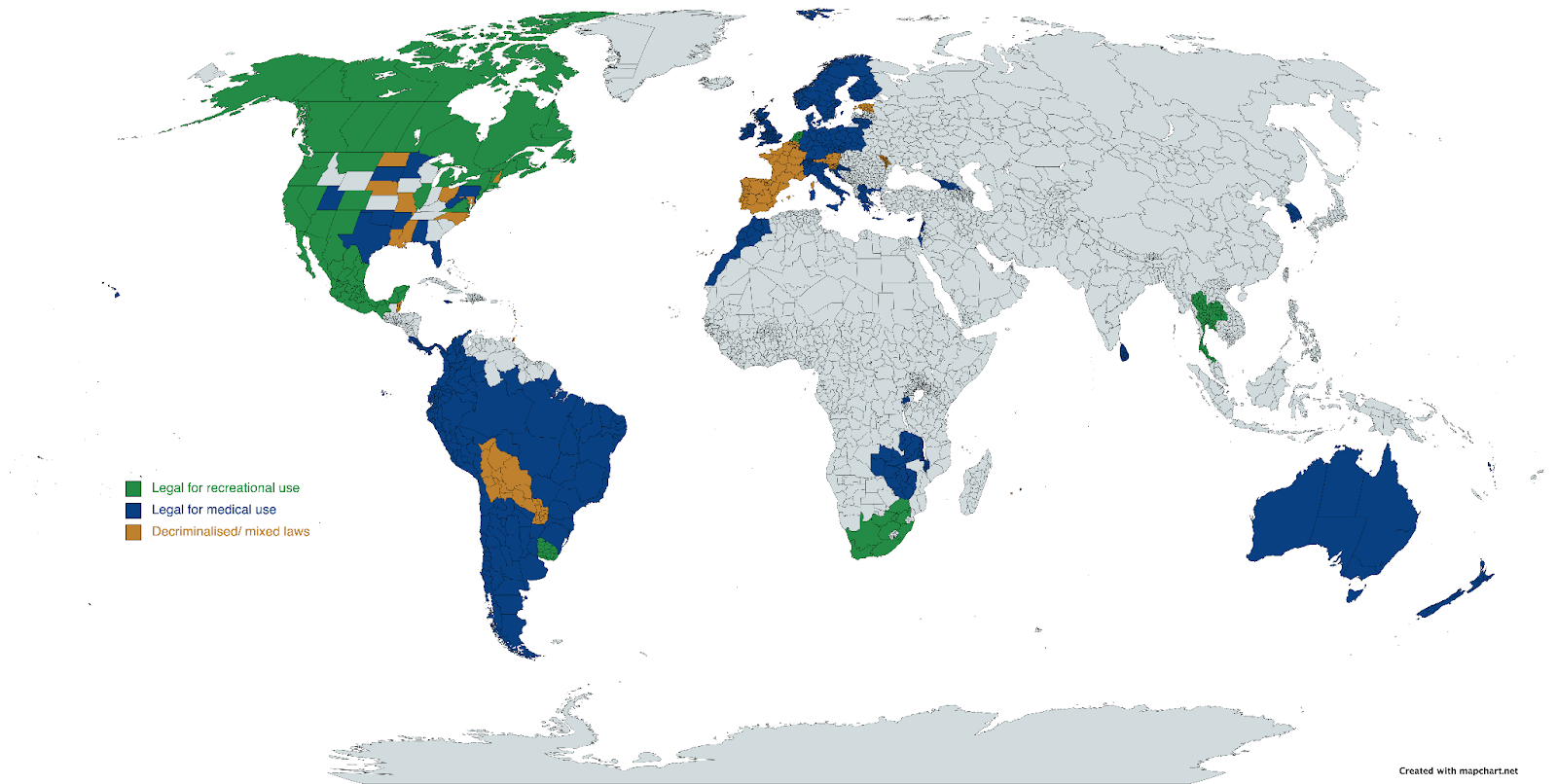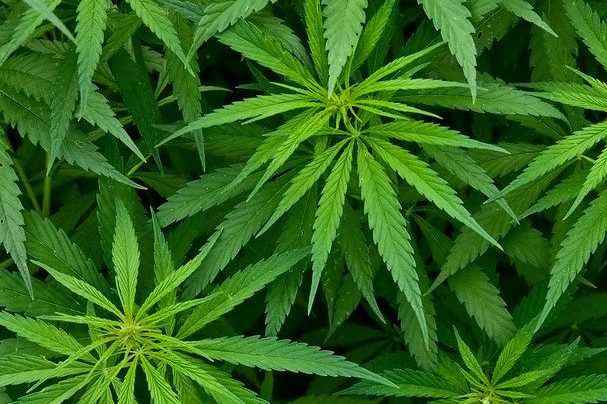Thailand is the first country in Asia to decriminalise cannabis, creating new economic opportunities. A Bloomberg study found that the cannabis market in Thailand is estimated to increase 15% annually through 2025, reaching over £1.1 billion.
Recreational, medical, and industrial applications make up the cannabis market. North America accounts for the largest market share owing predominantly to the increased medical and recreational legalisation of cannabis across many states. In addition, medical cannabis is legal in some European countries and has been extensively developed to treat chronic conditions. The increasing social acceptance of cannabis has made some countries adopt a decriminalisation policy (a non-criminal offence) for recreational uses. However, within Asia, many countries continue to have a no-tolerance stance on cannabis, with severe penalties (Fig.1).
Industrially, cannabis has been used for thousands of years through hemp (the US Federal Law defines hemp as any part of the cannabis plant containing no more than 0.3% THC concentration on a dry-weight basis, regardless of CBD content), with hemp fibres being lighter and stronger than steel. When refined, it can produce items such as textiles, biofuel, animal feed, food, among others. Nevertheless, the legality of hemp products varies widely amongst different countries.
A common theme amongst countries in Asia is the utilisation of the cannabis plant for only medical and industrial purposes, which remains strictly controlled. Thailand has taken a different approach, attempting to create a first-mover advantage in a region with strict neighbouring countries. This has come when COVID-19 and the lack of tourism for two years (making up an estimated 17% of GDP annually) have weakened the Thai economy. The government hopes the economic benefits of cannabis will boost the economy via three classifications: lucrative crop for agriculture, medical potential, and tourism.

Figure 1: Original World Map of Cannabis Law; recreational, medical and decriminalised as of October 2022, created in Mapchart.net. See colour code for the legality, bottom left.
The Science Behind Cannabis
Cannabis is a plant species that contains hundreds of cannabinoid chemicals, notably cannabidiol (CBD) and delta-9-tetrahydrocannabinol (d-9-THC, often abbreviated to THC). Cannabinoids can be phytocannabinoids (derived from plants) or endocannabinoids (produced naturally within the body; endogenously). The endocannabinoid neurotransmitter system is a natural cannabinoid receptor system in the body, believed to have regulatory roles in neuronal, vascular, metabolic, immune and reproductive systems; these control cognition, memory, motor functionality and nociception (pain reception). Phytocannabinoids produce their effects in the body by binding to receptors of the endogenous system, usually carefully regulated by homeostasis in the body. These include Cannabinoid 1 receptors (CB1Rs, primarily expressed in the brain) and Cannabinoid 2 receptors (CB2Rs, primarily expressed in immune cells, the spleen and the gastrointestinal system).
Recreational cannabis uses the phytocannabinoid THC, which acts psychotropically (affects the mental state) by increasing the release of dopamine, glutamate and acetylcholine in the brain. This is mediated by THC acting as a partial agonist of CB1Rs, usually bound by Anandamide and 2-arachidonoyl glycerol endocannabinoids. This prevents the release of the inhibitory neurotransmitter GABA (gamma-aminobutyric acid), responsible for downregulating the release of these neurotransmitters, which are responsible for producing feelings of euphoria – known as the ‘stoned’ effect.
Medical cannabis is primarily composed of the non-psychotropic CBD cannabinoid, as it does not produce the clinically unwanted ‘stoned’ effect of THC. Inhibited endocannabinoid function is the root of various disorders such as migraines, multiple sclerosis and Parkinson’s disease. External sources of CBD phytocannabinoid can compensate for an insufficient endocannabinoid system by mimicking endocannabinoids at CB1Rs and CB2Rs. Serotonin is a neurotransmitter and a ‘happy drug’ target often used for pain relief via the positive interaction with serotonergic receptors (5-HT1A/2A/3A). Another therapeutic use of CBD is to relieve moderate to severe neuropathic pain, in autoimmune diseases like multiple sclerosis and pain from cancer. Currently, the only CBD product approved by the US Food and Drug Administration (25th June 2018) is a prescription oil called Epidiolex, which is approved to treat two rare types of epilepsy, Lennox-Gastaut syndrome and Dravet syndrome.
The Economics of Cannabis
Firstly, the government is trying to promote cannabis as a cash crop. In June 2022, one million free cannabis plants were distributed to households nationwide. These hemp plants provide many agricultural benefits for farmers; about a third of Thailand’s labour force works in agriculture. Hemp is one of the fastest-growing plants, with Thailand’s tropical climate providing the ideal growing conditions. Furthermore, it is an effective weed suppressor and improves soil quality, making it useful for farmers in crop rotation and in the cultivation of rice, the most important crop in the country.
Secondly, the government hopes the surplus of cannabis will lead to increased medical applications. Thailand divides this into three medical categories: strong evidence of benefits (e.g., epilepsy), some evidence of benefit (e.g., Alzheimer’s disease) and conditions which may benefit from treatment (e.g., alleviating cancer symptoms). The forecasted medical cannabis market value in Thailand in 2024 is expected to be £220 million. The country hopes to leverage its credible medical tourism destination to provide new cannabis treatments unavailable in nearby regions, evident with the government constructing 38 nationwide clinics as a pilot scheme specialising in traditional and alternative cannabis-based medicine.
Lastly, the recreational cannabis market provides excellent potential for Thailand and tourism. Current legislation prohibits plant usage by those under the age of 20 and pregnant. Recreational cannabis for tourism has shown effectiveness in other countries, such as Barcelona and Amsterdam. Liu and Stronczak found that almost 50% of visitors were at least ‘somewhat’ motivated by cannabis legalisation to visit these countries. Furthermore, cannabis tourism could boost Thailand’s status as a wellness destination, with the kingdom having an estimated 40 million visitors in 2019. The recreational cannabis market is valued at around £400 million.
Nevertheless, the road to cannabis legalisation has not been smooth. Tourism has not rebounded as anticipated. Furthermore, the lack of regulation has led to importing illegal high-level overseas THC strains for recreational use. With official recreational and medical cannabis channels remaining expensive, many consumers still prefer to go through illegal channels where quality is unchecked. Consumer perception regarding cannabis for medical applications remains high; Assanangkornchai et al.’s survey found that 90% of locals supported medical cannabis. However, the government must continue to educate the public to lower social stigma and raise local consumption where tourism is currently volatile. While cannabis in Thailand is progressive, starkly contrasting neighbouring countries like Singapore, which has a zero-tolerance policy, Thailand is hoping that cannabis will boost tourism recreationally and have industrial and medical uses. Global sales for medical cannabis were estimated at £32 billion in 2021, and it’s predicted the market will soar to more than £100 billion by 2026. In due time, Thailand’s first-mover advantage in this green space might create economic and social benefits for the country and its people.






In Thailand, drugs are everywhere, which is why marijuana is easy to legalize